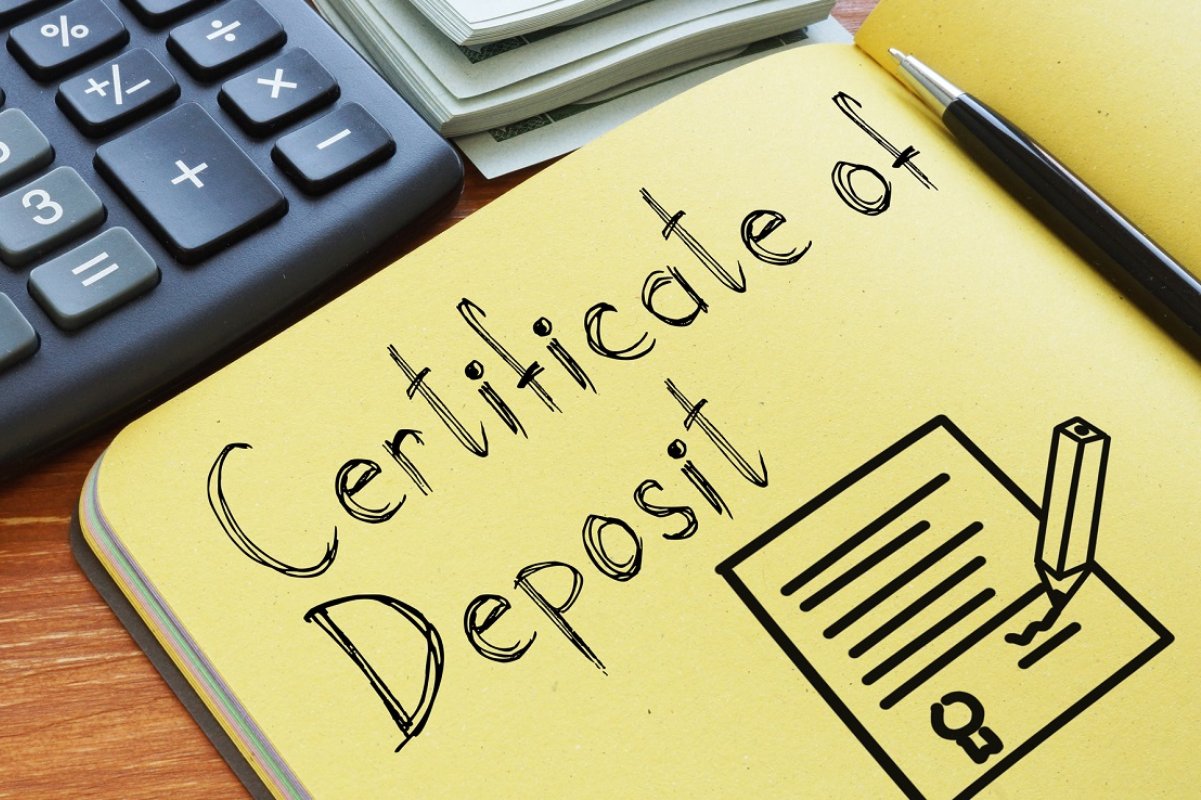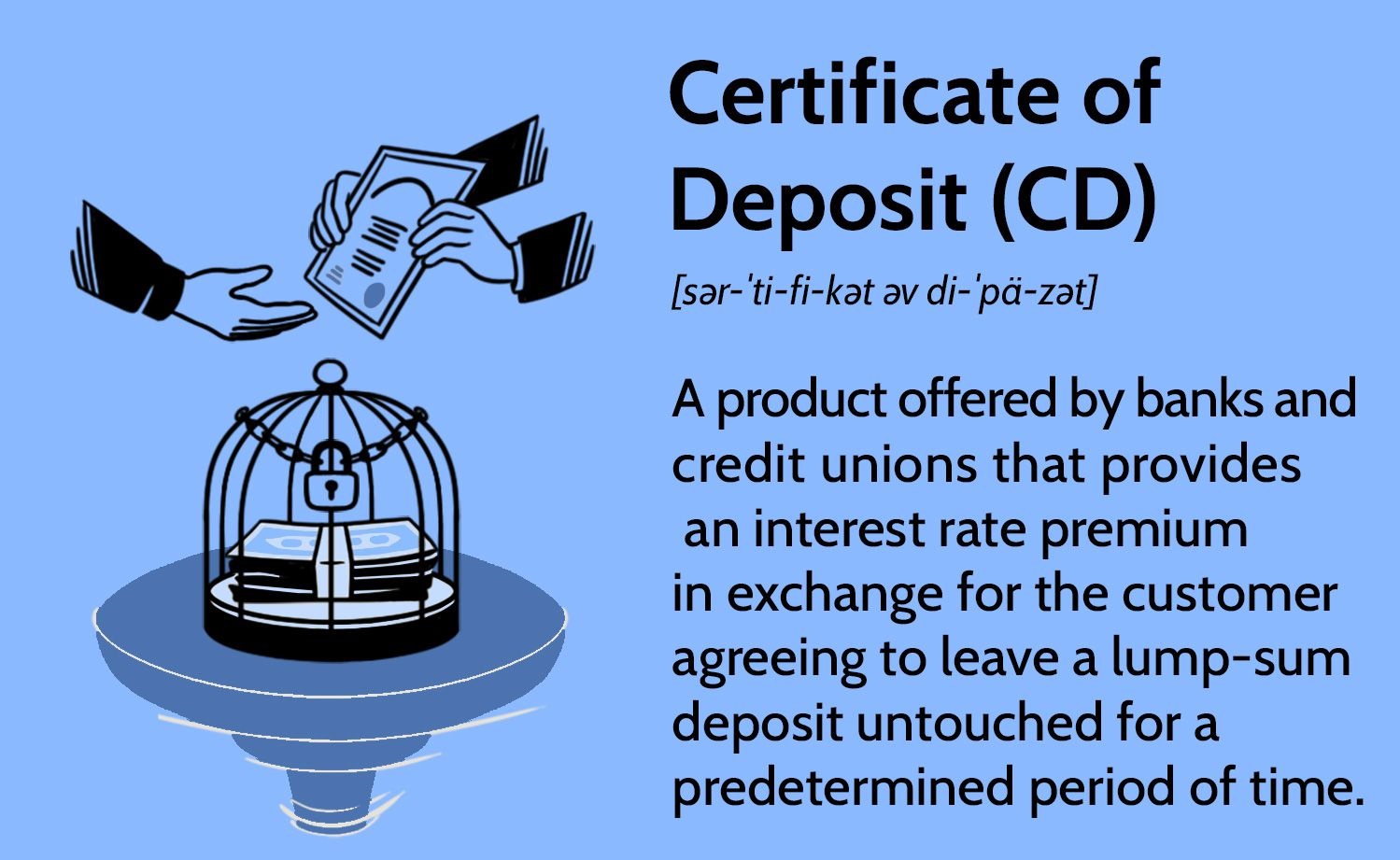Introduction
Welcome to the world of banking, where a variety of financial products and services are available to meet your saving and investment needs. One such product that you may come across is a Certificate of Deposit, commonly known as a CD. CDs are popular among individuals who want to earn a fixed return on their money over a specific period of time.
A CD is a type of time deposit offered by banks and financial institutions, where you deposit a certain amount of money for a set period, known as the term, and in return, you earn a fixed interest rate. The longer the term of the CD, the higher the interest rate tends to be. CDs are considered to be low-risk investments, making them an attractive option for those who value stability and predictability in their savings.
CDs function similar to savings accounts with a few key differences. When you deposit money into a CD, you agree to leave it untouched for the duration of the term. In return for this commitment, the bank offers you a higher interest rate compared to a regular savings account. This makes CDs an excellent option for individuals who have surplus funds that they can afford to lock away for a specific period of time.
CDs come in various types, each offering different features and benefits to suit different financial goals. Whether you’re looking for a short-term CD that matures in a few months or a long-term CD that spans several years, there is an option available to match your needs.
While CDs offer several advantages, it is important to consider some factors before investing. You should assess the interest rates, terms, and penalties associated with early withdrawal, as well as your own financial goals and liquidity needs.
In this article, we will delve into the world of CDs, exploring their definition, how they work, the different types available, as well as the advantages and disadvantages of investing in CDs. We will also discuss the factors to consider before opening a CD account and how to withdraw funds from a CD before its maturity.
So, if you’re ready to learn more about CDs and how they can fit into your financial strategy, let’s dive in.
Definition of CDs in Banking
A Certificate of Deposit (CD) is a financial product offered by banks and credit unions that allows individuals to deposit a sum of money for a fixed period in exchange for earning a predetermined interest rate. CDs are considered to be time deposits because the funds are locked in for a specific duration known as the term.
CDs are often referred to as “certificates” because when you open a CD, the bank provides you with a certificate that serves as evidence of your deposit. This certificate contains important information such as the term of the CD, the interest rate, and the maturity date.
CDs are different from regular savings accounts in that they offer higher interest rates. This is because you, as the investor, agree to keep the funds in the CD for the entire term, without making any withdrawals. Banks reward this commitment by offering higher interest rates compared to savings accounts, where funds can be withdrawn at any time.
The term of a CD can vary, ranging from a few months to several years. Typically, the longer the term, the higher the interest rate offered by the bank. For example, a 6-month CD may offer a lower interest rate compared to a 5-year CD. It’s important to note that once the term is chosen and the CD is opened, you cannot alter or access the funds until the maturity date, except in specific cases where early withdrawal is allowed.
CDs are a popular choice for individuals who have surplus funds and want to earn interest on their savings over a relatively short or long period of time. They are especially appealing to risk-averse investors who prioritize stability and guaranteed returns. Additionally, CDs are insured by the Federal Deposit Insurance Corporation (FDIC) for up to $250,000 per depositor, providing an extra layer of protection to account holders.
Overall, Certificates of Deposit offer a secure and predictable way to grow your savings. In the following sections, we will explore more about how CDs work, the different types available, and the advantages and disadvantages of investing in them.
How CDs Work
Understanding how Certificates of Deposit (CDs) work is essential before deciding to invest in them. Here’s a step-by-step breakdown of how CDs operate:
- Choosing the CD: Start by selecting the CD that fits your financial goals and needs. Consider the term length, interest rate, and any additional features or benefits offered by the bank or credit union.
- Opening the CD: Once you’ve chosen a CD, you’ll need to open an account with the bank or credit union. Provide the required identification and any necessary funds to initiate the CD.
- Deposit Amount: Specify the amount you want to deposit into the CD. There may be a minimum deposit requirement, depending on the institution and type of CD.
- Term Length: Determine the duration for which you’re willing to leave the funds untouched. This can range from a few months to multiple years. The longer the term, the higher the interest rate tends to be.
- Interest Rate: The bank will offer you a fixed interest rate for the CD. This rate remains constant throughout the term, ensuring a predictable return on your investment.
- Interest Calculation: The interest on CDs is typically compounded at regular intervals, such as yearly, semi-annually, or quarterly. This means that the interest you earn in one period is added to the principal, and subsequent interest calculations are based on the updated balance.
- Earning Interest: As time progresses, your CD will accrue interest based on the interest rate and compounding frequency. This interest is typically paid out at the end of each compounding period.
- Early Withdrawal Penalty: It’s important to note that CDs are designed for a fixed-term commitment. If you withdraw funds before the maturity date, you may be subject to an early withdrawal penalty. This penalty varies among institutions and is typically a percentage of the interest earned or a set number of months’ worth of interest.
- Maturity Date: Once the term of the CD is complete, it reaches its maturity date. At this point, you have a few options: you can choose to renew the CD with the same or different terms, withdraw the funds, or transfer them to another account.
It’s important to carefully consider the term length and any liquidity needs before opening a CD. If you anticipate needing access to the funds before the maturity date, it may be worth exploring CDs with shorter terms or alternatives that offer more flexibility.
Now that we have a better understanding of how CDs work, let’s explore the different types of CDs available in the next section.
Types of CDs
When it comes to Certificates of Deposit (CDs), there are several types available, each designed to cater to different financial goals and preferences. Let’s take a look at some of the common types of CDs:
- Traditional Fixed-Rate CDs: These are the most basic and common type of CDs. With a traditional fixed-rate CD, you deposit a specific amount of money for a predetermined term and earn a fixed interest rate throughout the duration of the CD. The interest rate is typically higher than that of a regular savings account, and the longer the term, the higher the interest rate.
- Bump-Up CDs: A bump-up CD offers a unique feature that allows you to “bump up” your interest rate if the bank’s rates increase during your CD’s term. This gives you the opportunity to take advantage of rising interest rates without needing to open a new CD. However, these CDs may have slightly lower initial interest rates compared to traditional fixed-rate CDs.
- Step-Up CDs: Similar to bump-up CDs, step-up CDs also offer increasing interest rates over time. However, with step-up CDs, the rate increases are predetermined. For example, the CD may have a set interest rate for the first year and then increase every subsequent year until maturity. These CDs provide a guaranteed and predictable increase in earnings.
- Callable CDs: Callable CDs are CDs that can be “called back” by the issuing bank before the maturity date. This gives the bank the option to return your principal early. While callable CDs may offer higher interest rates, they also come with the risk of possible early termination, which could impact your investment strategy.
- Jumbo CDs: Jumbo CDs are a type of CD that requires a large minimum deposit, usually starting at $100,000. In return for the higher deposit amount, jumbo CDs typically offer higher interest rates compared to regular CDs. These CDs are ideal for individuals with a substantial amount of money they wish to invest.
- No-Penalty CDs: No-penalty CDs provide flexibility in the event you need to access your funds before the maturity date without incurring penalties. These CDs allow you to withdraw your funds without penalty, often after a specific waiting period. However, no-penalty CDs may have lower interest rates compared to traditional CDs.
- IRA CDs: IRA CDs are specifically designed for Individual Retirement Accounts (IRAs). These CDs offer tax advantages, such as tax-deferred or tax-free growth, depending on the type of IRA. IRA CDs provide a secure way to save for retirement with the added benefit of predictable returns.
It’s important to explore the different types of CDs available and consider your financial goals, risk tolerance, and liquidity needs before deciding which type of CD is most suitable for you.
In the next section, we will discuss the advantages and disadvantages of investing in CDs, helping you make an informed decision about incorporating CDs into your investment portfolio.
Advantages of CDs
Certificates of Deposit (CDs) offer a range of benefits that make them an attractive investment option for many individuals. Let’s explore some of the advantages of investing in CDs:
- Stability: CDs are considered to be low-risk investments. When you deposit money into a CD, you can feel confident knowing that your funds are secure and protected. The fixed interest rate and predetermined term provide stability and predictability in your earnings.
- Guaranteed Returns: With a CD, you know exactly how much you will earn during the term. The interest rate remains fixed throughout the CD’s duration, ensuring consistent returns on your investment. This can be particularly appealing for individuals who prioritize stability and want to avoid the volatility that comes with other types of investments.
- Higher Interest Rates: Compared to regular savings accounts, CDs typically offer higher interest rates. This means that your money can grow at a faster rate, especially if you opt for longer-term CDs. Higher interest rates can translate into increased earnings and help you meet your financial goals more quickly.
- Diversity and Portfolio Allocation: CDs provide a way to diversify your investment portfolio. They can complement other investments such as stocks or bonds, offering a less volatile option that contributes to a balanced portfolio. By allocating a portion of your savings to CDs, you can spread your risk and enhance your overall financial strategy.
- Insured by FDIC: CDs offered by banks are insured by the Federal Deposit Insurance Corporation (FDIC) up to $250,000 per depositor. This means that even if the bank were to face financial difficulties, your principal and earned interest are protected. FDIC insurance provides peace of mind and adds an extra layer of security to your investment.
- Flexibility in Terms: CDs come in various term lengths, allowing you to choose the option that best aligns with your financial goals. Whether you’re saving for a short-term expense or planning for a long-term goal, there is a CD term available to suit your needs. This flexibility allows you to tailor your investment strategy to your specific timeframe and objectives.
It’s important to consider these advantages when deciding whether to invest in CDs. However, it’s equally important to be aware of the potential disadvantages, which we will explore in the next section.
Note: Remember to consult with a financial advisor before making any investment decisions to ensure they align with your unique financial situation and goals.
Disadvantages of CDs
While Certificates of Deposit (CDs) offer several advantages, it’s important to consider the potential disadvantages before investing. Here are some key drawbacks to keep in mind:
- Limited Liquidity: CDs are designed to be held until maturity, which means your funds will be locked in for the duration of the term. If you need access to your money before the CD matures, you may incur early withdrawal penalties and lose some of the interest earned. This lack of liquidity can be a disadvantage if you anticipate needing immediate access to your funds.
- Opportunity Cost: While CDs provide stability and guaranteed returns, they generally offer lower interest rates compared to other investments that come with a higher level of risk. This opportunity cost means that you may not maximize your potential earnings by allocating all your funds to CDs, especially in a rising interest rate environment where other investments may offer higher returns.
- Inflation Risk: CDs are fixed-rate investments, which means the interest rate remains steady throughout the term. Inflation, however, can erode the purchasing power of your investment over time. If the rate of inflation exceeds the interest rate on your CD, the real value of your money may decrease.
- Missed Investment Opportunities: By locking your funds into a CD for a specific term, you potentially miss out on other investment opportunities that may arise during that time. If you have the ability to keep your money invested in a more flexible investment vehicle, you may have the chance to take advantage of higher returns or capitalize on market conditions.
- Callable CD Risk: Callable CDs can be terminated early by the issuing bank, acting as a disadvantage for investors. If interest rates decline, the bank may choose to call back the CD and repay your principal before maturity. While you will receive your full principal, you may lose out on potential future interest earnings.
- Credit Union Risk: CDs offered by credit unions may pose a risk if the credit union becomes financially unstable. Unlike banks, credit unions are not insured by the FDIC but may have coverage from the National Credit Union Administration (NCUA). It’s important to research the financial stability and insurance coverage of the credit union before investing.
Considering these disadvantages alongside the advantages of CDs will help you make a well-informed decision about incorporating them into your financial strategy. It’s important to carefully assess your financial goals, liquidity needs, and risk tolerance before committing to a CD investment.
Next, we will discuss some key factors to consider before investing in CDs, helping you navigate the decision-making process.
Factors to Consider Before Investing in CDs
Before investing in Certificates of Deposit (CDs), it’s crucial to take several factors into consideration to ensure they align with your financial goals and needs. Here are some key factors to evaluate before committing to a CD investment:
- Term Length: Determine the length of time you’re willing to leave your funds locked in a CD. Consider your financial goals, liquidity needs, and any upcoming expenses or investments. Shorter-term CDs offer more flexibility, while longer-term CDs often provide higher interest rates.
- Interest Rates: Compare the interest rates offered by different banks or credit unions. Research current market rates to ensure you’re getting a competitive interest rate on your CD. Higher interest rates can maximize your earnings over the term.
- Early Withdrawal Penalties: Understand the penalties associated with early withdrawal from a CD. Life is unpredictable, and you may need access to your funds before the CD matures. Analyze the potential penalties and determine if they are worth the risk, considering your liquidity needs.
- Financial Stability: Research the financial stability of the bank or credit union offering the CD. Ensure that they have a positive reputation and are backed by insurance such as the Federal Deposit Insurance Corporation (FDIC) or the National Credit Union Administration (NCUA) to protect your deposits.
- Consider Your Cash Flow: Evaluate your cash flow and determine if you can afford to have a portion of your funds tied up in a CD. It’s important to maintain an emergency fund or have access to adequate liquidity to cover unexpected expenses.
- Your Risk Tolerance: Evaluate your risk tolerance and investment objectives. CDs are conservative investments with low risk and low returns compared to other investment options. If you are seeking higher returns or have a higher risk appetite, you may consider alternative investments.
- Alternative Investments: Consider other investment options available to you. Assess whether other types of investments, such as stocks, bonds, or mutual funds, align better with your financial goals and risk tolerance. Diversifying your portfolio may provide greater potential for growth.
- Tax Considerations: Understand any tax implications associated with earning interest on your CD. Interest earned on CDs is typically subject to income tax. Explore tax-advantaged accounts such as Individual Retirement Accounts (IRAs) if you are looking for tax benefits.
By thoroughly considering these factors, you can make an informed decision about whether investing in CDs aligns with your financial strategy and goals. It’s always wise to consult with a financial advisor who can provide personalized guidance based on your individual circumstances.
Next, we will explore how to open a CD account, guiding you through the process of getting started with a CD investment.
How to Open a CD Account
Opening a Certificate of Deposit (CD) account is a straightforward process that can be completed in a few simple steps. Here’s a guide to help you get started with opening a CD account:
- Research: Begin by researching different banks or credit unions that offer CDs. Compare their interest rates, terms, and any additional features or benefits they may provide. Look for institutions that are financially stable and insured by the Federal Deposit Insurance Corporation (FDIC) or the National Credit Union Administration (NCUA) for added security.
- Select the CD: Choose the type of CD that aligns with your financial goals and preferences. Consider the desired term length, interest rate, and any specific features such as a step-up or bump-up option that may be of interest to you.
- Gather Required Information: Gather the necessary identification and documentation required to open a CD account. This typically includes your Social Security number, photo identification (such as a driver’s license or passport), and proof of address (such as a utility bill or bank statement).
- Contact the Financial Institution: Reach out to the bank or credit union of your choice to inquire about the process of opening a CD account. You can do this by visiting the bank’s branch or contacting their customer service via phone or email.
- Initiate the Application: Once you have connected with the financial institution, they will guide you through the application process. Provide the required information and complete the necessary forms. You may also need to specify the deposit amount and the term length you have chosen.
- Make the Deposit: Transfer the funds required for the initial deposit into the CD account. Most financial institutions accept various payment methods, including cash, check, or electronic transfer. There may be a minimum deposit requirement that you need to meet.
- Receive Confirmation: After making the deposit, you will receive a confirmation from the financial institution. This confirmation will outline the details of the CD, including the term length, interest rate, and maturity date. Keep this confirmation in a safe place for future reference.
- Monitor and Manage: Once your CD account is open, regularly monitor its progress and keep track of its maturity date. Some banks offer online banking services that enable you to conveniently manage your CD account, check the balance, and view statements.
Remember to review the terms and conditions of the CD agreement and familiarize yourself with any penalties or restrictions associated with early withdrawal. It’s essential to fully understand the terms of the CD before finalizing the account opening process.
By following these steps, you can successfully open a CD account and start benefiting from the fixed interest rate and guaranteed returns that CDs offer.
In the next section, we will discuss the process of withdrawing funds from a CD account before its maturity date.
How to Withdraw from a CD Before Maturity
While Certificates of Deposit (CDs) are intended to be held until maturity, there may be situations where you need to access the funds before the agreed-upon term. Withdrawing from a CD before maturity may result in penalties or restrictions, but it is still possible. Here’s a step-by-step guide on how to withdraw from a CD before its maturity date:
- Review the Terms: First and foremost, review the terms and conditions of your CD agreement. Pay close attention to any penalties, restrictions, or fees associated with early withdrawal. Different banks and credit unions may have varying policies, so it’s crucial to understand the consequences of withdrawing early.
- Contact the Institution: Reach out to your bank or credit union to discuss your intention to withdraw from your CD before maturity. Contact their customer service or visit a branch for further assistance. They will provide you with guidance on the specific steps to follow based on their policies.
- Understand the Penalties: Thoroughly understand the penalties that may be imposed for early withdrawal. Commonly, these penalties are a percentage of the interest earned or a set number of months’ worth of interest. Be prepared for the potential reduction in earnings.
- Weigh the Financial Implications: Evaluate the financial implications of early withdrawal. Consider whether the penalties outweigh the need for immediate access to the funds. If the reason for withdrawal is essential, such as a financial emergency, the penalties may be justifiable.
- Provide Withdrawal Notice: Some financial institutions require advance notice of your intention to withdraw from a CD before maturity. Follow the prescribed procedure for providing the necessary notice to initiate the withdrawal process.
- Complete Withdrawal Documentation: Fill out the required withdrawal documentation provided by the bank or credit union. This paperwork ensures that your withdrawal is properly recorded, and any applicable penalties are accounted for.
- Choose the Withdrawal Method: Select the withdrawal method for receiving your funds. Common options include receiving a check in the mail, transferring the funds to your bank account, or depositing the funds into another account at the same financial institution.
- Ensure Proper Account Closure: Confirm with the institution that your CD account is closed after the withdrawal. Verify that any remaining funds, including interest earned up to the date of withdrawal, are correctly disbursed.
Remember, withdrawing from a CD before maturity should be done only when absolutely necessary, as it may impact your earnings and overall investment strategy. It’s always advisable to consult with a representative from your financial institution or a financial advisor to fully understand the consequences and explore alternative options before making a decision.
In the final section, we will conclude our discussion on CDs, summarizing the key points covered throughout the article.
Conclusion
Certificates of Deposit (CDs) are a popular investment option for individuals looking for stability, guaranteed returns, and a low-risk savings tool. CDs offer several advantages, such as stable interest rates, higher returns compared to regular savings accounts, and the guarantee of principal protection up to a certain limit.
Before investing in CDs, it’s essential to consider various factors such as term length, interest rates, penalties for early withdrawal, financial stability of the institution, and your own liquidity needs and risk tolerance. By evaluating these factors, you can make an informed decision that aligns with your individual financial goals.
There are different types of CDs available to cater to diverse needs, including traditional fixed-rate CDs, bump-up CDs, step-up CDs, callable CDs, jumbo CDs, no-penalty CDs, and IRA CDs. Each type offers unique features and benefits, allowing you to choose the one that best suits your financial objectives.
While CDs provide numerous advantages, there are also potential disadvantages to consider. Limited liquidity, opportunity cost, inflation risk, missed investment opportunities, callable CD risk, and credit union risk are factors that must be carefully evaluated before committing to a CD investment.
Opening a CD account involves thorough research, selecting the appropriate CD, gathering required information, contacting the financial institution, initiating the application process, making the deposit, and receiving confirmation of the CD details. Ongoing management and monitoring of the CD account are essential to ensure you stay on track towards your goals.
Should the need arise, it is possible to withdraw from a CD before its maturity date. However, this may result in penalties and restrictions, so careful consideration of the financial implications is essential. Consult with your financial institution and understand their policies before proceeding with an early withdrawal.
In conclusion, Certificates of Deposit can be a valuable tool to meet your savings and investment objectives. By carefully assessing your financial needs, conducting thorough research, and understanding the terms and conditions, you can utilize CDs as a secure and predictable component of your overall financial strategy.

























